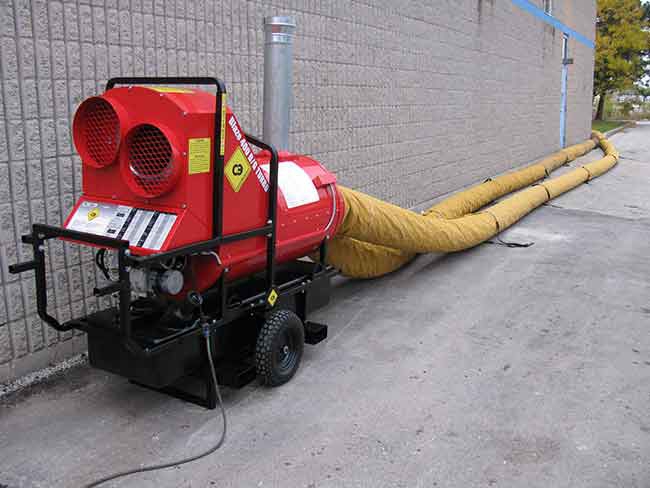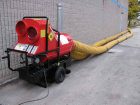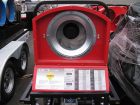
Heater design innovations
By Daniel Campo
Features Tech tipsPortable, indirect-fired heaters can meet a range of job site demands, from oil and gas production sites to small residential construction projects, offering opportunities to rental centers wherever temporary heat is required.
 Being able to add longer ducting is about more than just convenience. Backward incline fan designs prevent hot air from backing up into the heater even if the ducting is kinked
Being able to add longer ducting is about more than just convenience. Backward incline fan designs prevent hot air from backing up into the heater even if the ducting is kinked Traditionally, units in the 400,000 BTU range, because they run off a 120V 15 amp service, offer flexibility across a range of rental applications and are relatively common in most rental centers in locations where below-freezing temperatures are common. But new advances in heater design, developed specifically with rental applications in mind, are set to improve your ROI from your heat fleet by decreasing service calls, stabilizing power draws, increasing ducting capacity and improving fuel efficiency.
COMMON PROBLEMS
For many years, indirect-fired heaters in that 400,000 BTU range showed an inrush on the motor on start-up. They were limited to 24 feet of ducting and were very noisy when operating. On job sites, one of the biggest problems with heaters is power supply. While many models of heaters draw 12 amps or 14 amps while operating, inrush when the fan starts could jump the power draw up to, for example, 20 amps. This spike could lead to failures – tripped breakers – which increase downtime and can increase service calls back to the rental center for support.
Ducting can also create job site problems. While a rental center may set up the heater with the 24 feet of ducting it can adequately handle, someone on the job site may decide they need heat further into the building or up to the next floor of the building. They add ductwork or they kink or bend the ducts and create more static pressure. This creates more stress on the heater and on the fan. Hot air can back up into the heater and, all of a sudden, limit switches are going or the burner coupler fails. Not only do you have an immediate need for a service call, but failures such as this can shut down a project for hours when they occur during critical operations such as heating a space ahead of concrete pouring.
Avoid the rush
Today, some new heater models use a fan that provides a solution to a couple of problems. Sourced from Europe, backward incline fans position the motor in the center of the fan and use an inlet cone. These fans are more efficient than an axial fan, with higher static pressure and will support longer ducting. The motor has no inrush; it starts slowly and builds to 8.5 amp draw.
This offers advantages to the rental store. First, with no inrush and a lower amp motor, there’s no spike in power demand when the heater starts up. These means fewer problems with power supplies and job-site circuit breakers, resulting in fewer calls back to the rental store.
LONGER DUCTING, FEWER PROBLEMS
Second, longer ducting can increase utility for your customers. Advanced heater models will support up to 150 feet of ducting, more than six times the length of older systems. This offers flexibility in applications where the heater might need to sit 30 or 40 feet away from the area being heated or where longer ducting is needed to move heat into a building or other space. Backward incline fan design is partly responsible for this performance improvement as well. The advantage of the backward incline fan is the inherent design of the inlet cone which helps guide the incoming air, and the small distance between blades that helps support the static pressure. Even if a contractor kinks the duct or adds more than the recommended length, the inlet cone helps keep hot air from backing up into the heater and causing problems that result in service calls.
RECYCLE YOUR AIR
An additional feature of advanced heater models is that they offer recirculating capabilities. By drawing air out the space being heated rather than cold outside air, the heater can operate much more efficiently. We estimate savings in the 30 per cent or higher range. Take a quick look at the potential impact that can have. Operating 24 hours per day, seven days per week, a 400-BTU Turbo model from Campo will use about 2.85 gallons of fuel per hour. Over the course of a week, it consumes 480 gallons. Recirculating the air can reduce that by 30 per cent, which means burning about 336 gallons of fuel – a savings of more than 140 gallons. If you use $3 per gallon just for round numbers, that’s $420 you helped a customer save.
DIAGNOSTIC SYSTEMS SAVE DOWNTIME
A few other advantages can help you and your customers. Look for models that include a remote thermostat. Either on its own or combined with a recirculation system, this will help improve efficiency. Campo Equipment includes a voltmeter on the heater control panel because, when we get calls about a heater being down, in the great majority of cases, it is power related. A contractor might call and explain that the voltmeter is showing 120, but the system isn’t running. When we ask him to turn on the manual fan override to see the actual voltage the fan draws, it could drop right out to 80 volts and we know that’s the problem. They can address the power issue on the job site. Similarly, we fit the units with pressure gauges for the burners because this, too, can help provide quick troubleshooting.
Finally, late model heaters provide far quieter operation. This adds to operator comfort, but it’s also an advantage in securing rental business where quiet operation may have specific application value. This could be in residential construction, work in or near office building or health care facilities, and so forth.
Improvements in heater technology mean you and your customer do not have to put up with many of the common aggravations that come with renting portable heat. Fewer service calls and happier customers equals profits for your store.
About the author
Daniel Campo is president of Campo Equipment, based in Brampton, Ont.
Print this page


Leave a Reply